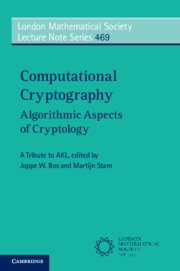Book contents
- Frontmatter
- Contents
- List of Contributors
- Preface
- 1 Introduction
- Part I Cryptanalysis
- 2 Lattice Attacks on NTRU and LWE: A History of Refinements
- 3 History of Integer Factorisation
- 4 Lattice-Based Integer Factorisation: An Introduction to Coppersmith’s Method
- 5 Computing Discrete Logarithms
- 6 RSA, DH and DSA in the Wild
- 7 A Survey of Chosen-Prefix Collision Attacks
- Part II Implementations
- References
- Index
3 - History of Integer Factorisation
from Part I - Cryptanalysis
Published online by Cambridge University Press: 11 November 2021
- Frontmatter
- Contents
- List of Contributors
- Preface
- 1 Introduction
- Part I Cryptanalysis
- 2 Lattice Attacks on NTRU and LWE: A History of Refinements
- 3 History of Integer Factorisation
- 4 Lattice-Based Integer Factorisation: An Introduction to Coppersmith’s Method
- 5 Computing Discrete Logarithms
- 6 RSA, DH and DSA in the Wild
- 7 A Survey of Chosen-Prefix Collision Attacks
- Part II Implementations
- References
- Index
Summary
In Chapter 3, History of Integer Factorisation, Samuel S. Wagstaff, Jr gives a thorough overview of the hardness of one of the cornerstones of modern public-key cryptography. The history starts with the early effort by Eratosthenes and his sieve, eventually leading to the modern number field sieve, currently the asymptotically fastest general-purpose integer factorisation method known. Also included are 'special' integer factorisation methods like the elliptic-curve method, where the run-time depends mainly on the size of the unknown prime divisor. Modern factorisation efforts often include a gradual escalation of different methods, so it is essential to be familiar with a wide range of methods and the essence of all relevant algorithms is explained clearly.
Information
- Type
- Chapter
- Information
- Computational CryptographyAlgorithmic Aspects of Cryptology, pp. 41 - 77Publisher: Cambridge University PressPrint publication year: 2021
